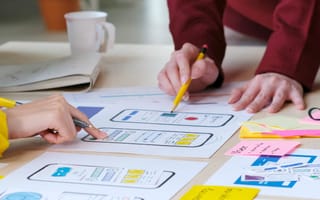Given its focus as a job-hunting platform for those in healthcare, a smooth user experience is important to Vivian Health, perhaps now more than ever.
“With all the challenges facing healthcare professionals today, the last thing they need is to figure out how to use a service or why some details look or work differently,” said Steve Jensen, a lead UX engineer at the company.
Adhering to solid design principles for the user’s benefit, of course, is one thing. But other stakeholders are required in order to bring a vision to fruition, or else it can’t get totally off the ground. For Jensen, the symbiosis between design and another core discipline — engineering — is what resonates with him when reflecting on the moves happening in UX at the moment.
“We’re most excited about a trend that has been decades in the making — the increasing convergence of design and engineering in the product development lifecycle,” Jensen said.
According to Jensen, having the two crafts operate in concert is crucial: It helps give the former an idea of the practicality of their work, while while bequeathing the latter with a feeling for aesthetics. In fact, that’s part of the reason why Vivian Health has maintained a UX engineering presence on its design team.
Built In Colorado connected with Jensen to learn more about how these respective areas come together at the company and how he anticipates this partnership to continue down the road.
You mentioned that the convergence of design and engineering is a trend that’s really inspiring you at the moment. Tell me how that’s come about during your time as a design professional.
As design systems have steadily evolved from the days of living style guides and graphic standards manuals, there have always been lockstep updates on the engineering side of the house to keep elements consistent or to reduce repetition. I remember being blown away by object-oriented CSS, then the large-scale scrum framework and SasS. With React, the design and engineering worlds are closer than they ever have been — components designed in Figma are built in React and React Native and shared in Storybook, all for easy plug-and-play use. This frees engineers to focus on data modeling, APIs and backend concerns.
That coupling is going to continue to get tighter, and teams will continue to get better at achieving the experience goals that design teams have been striving for. Ultimately, the user wins out with an ever-more polished and consistent experience.
We’re most excited about the increasing convergence of design and engineering in the product development lifecycle.”
How do you plan to incorporate this trend in your work in the year ahead?
We leaned heavily into this trend at Vivian, building a UX engineering team within the design organization early in our company’s history. As the design and engineering teams have grown and new features were built, both the product and codebase added new complexity and tech debt. Early investments in consolidating elements that had been built and rebuilt over time were instrumental in our rebrand from NurseFly to Vivian last year, which touched every user-facing portion of the site and mobile apps.
We’re excited to craft more of the user experience out of these reusable and accessible components in the year ahead and to continue to advance them to incorporate more moments of delight — hints of animation, clear feedback loops, a focus on accessibility — while also continuing to evolve as our brand evolves.
How do you see this trend evolving in the future?
Including engineers on the design team seems glaringly obvious in hindsight, yet it’s a move that doesn’t appear to be happening at most companies. In addition to an extra element of quality assurance, the close collaboration gives designers a better sense for the feasibility of designs and gives engineers a better “design eye.”
That trend will continue, but will be driven by tooling that better merges the two disciplines. Figma can give you CSS output, but it’s inherently biased toward visuals even though HTML is a structured document. Mockups only give you the visual aspects of what a page should look like, not the element semantics that are so important for the many ways that people consume and interact with technology, like screen readers or navigating by keyboard. Design prototyping will continue to evolve to focus on the structural nature of the web and mobile apps, which ultimately leads to a more consistent and navigable experience for our users.
While these tools continue to evolve to better handle the needs of designers and UX engineers, we’ll focus on process and collaboration to drive that evolution through our integrated team structure.







